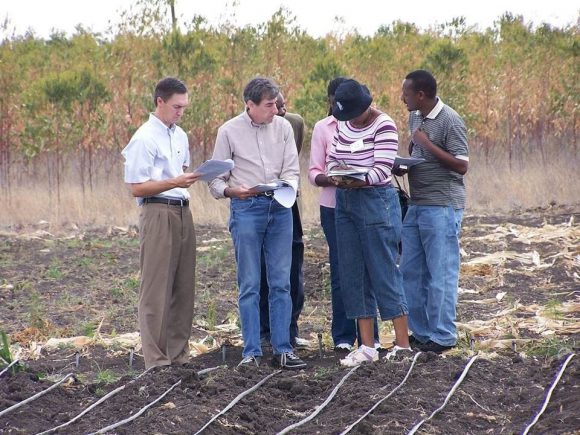
Michael Braverman (center), IR-4’s manager of International Capacity Building Programs explains the Good Laboratory Practice requirements of a field trial to Lucy Namu (right foreground), head of Quality Assurance and Laboratory Accreditation of Kenya Plant Health Inspectorate Service (KEPHIS) and senior program manager, Science & Technology Capacity Building Branch USDA/FAS Jason Sandahl (left).
On December 11, 2017, seventeen senior government officials signed a joint statement acknowledging the productive work of the World Trade Organization’s (WTO) Standards and Trade Development Facility (STDF) in building knowledge and capacity for developing countries in the area of pesticide maximum residue levels (MRLs).
STDF provided the funding for the USDA’s IR-4 Project to provide the direct training for each country involved. IR-4 trained the countries in how to conduct both field and laboratory trials under Good Laboratory Practices. The data from these trials was submitted to the Joint FAO/WHO Meeting on Pesticide Residues (JMPR) with the ultimate goal of establishing new MRLs based on this data.
U.S. Secretary of Agriculture, Sonny Perdue, issued the following statement in response to the joint statement signed at the 11th WTO Ministerial Conference in Buenos Aires: “USDA applauds the joint statement on pesticide MRLs issued today at the WTO ministerial in Buenos Aires. The 17 signatory countries have come together to recognize that farmers worldwide must be able to access the full range of available tools and technologies in order to remain productive and competitive. But too often, that access is hampered by non-scientific regulatory barriers.”
Marlynne Hopper from the office of STDF of the WTO commented, “We were delighted to see this reference to the Standards and Trade Development Facility (STDF) in the Joint Statement from MC-11, signed by 17 governments. It’s wonderful to see this concrete illustration of how the three STDF MRL projects in Africa, ASEAN and Latin America – with USDA, IR-4/Rutgers University and the many other public and private sector partners – helped to build knowledge and capacity on pesticide MRLs in developing countries, and also played a catalytic role in encouraging more regional and international collaboration on this topic.”
Jason Sandahl, senior program manager, USDA/FAS Science & Technology Capacity Building Branch, commented, “Thanks IR-4, for being such great partners with USDA. This program is just starting, and we expect to see even greater successes in the future.”
IR-4 executive director, Jerry Baron stated, “IR-4’s mission is to bring pest management solutions to growers thereby becoming partners in agriculture. We are proud to be associated with this work and thank the STDF for providing the means to conduct this research.”
About IR-4
The IR-4 Project is a multi-agency-funded program for facilitating the registration of existing pesticides for use on specialty crops. Established in 1963 as a collaborative effort of the UDSA-National Institute of Food and state Agricultural Experiment Stations at Land Grant Universities, USDA Agricultural Research Service (ARS), the crop protection industry, specialty crop growers and commodity associations. Research is conducted in coordination with the Environmental Protection Agency. The IR4 Project assists in the collection of residue and efficacy data in support of the registration of minor uses of pesticides. The IR-4 Project is headquartered at Rutgers and is geographically diversified through regional centers housed in Land Grant Universities and ARS facilities across the US.
Learn more about IR-4 and these projects. Read about Standards and Trade Development Facility (STDF). Review the joint statement.
Also visit Western Press to read about how Dr. Michael Braverman and the staff of the IR4 project at Rutgers University have provided important support for the registration of AF36 products, a biological pesticide that has helped growers reduce aflatoxin levels in western cotton, corn, pistachios, figs, and almonds.

